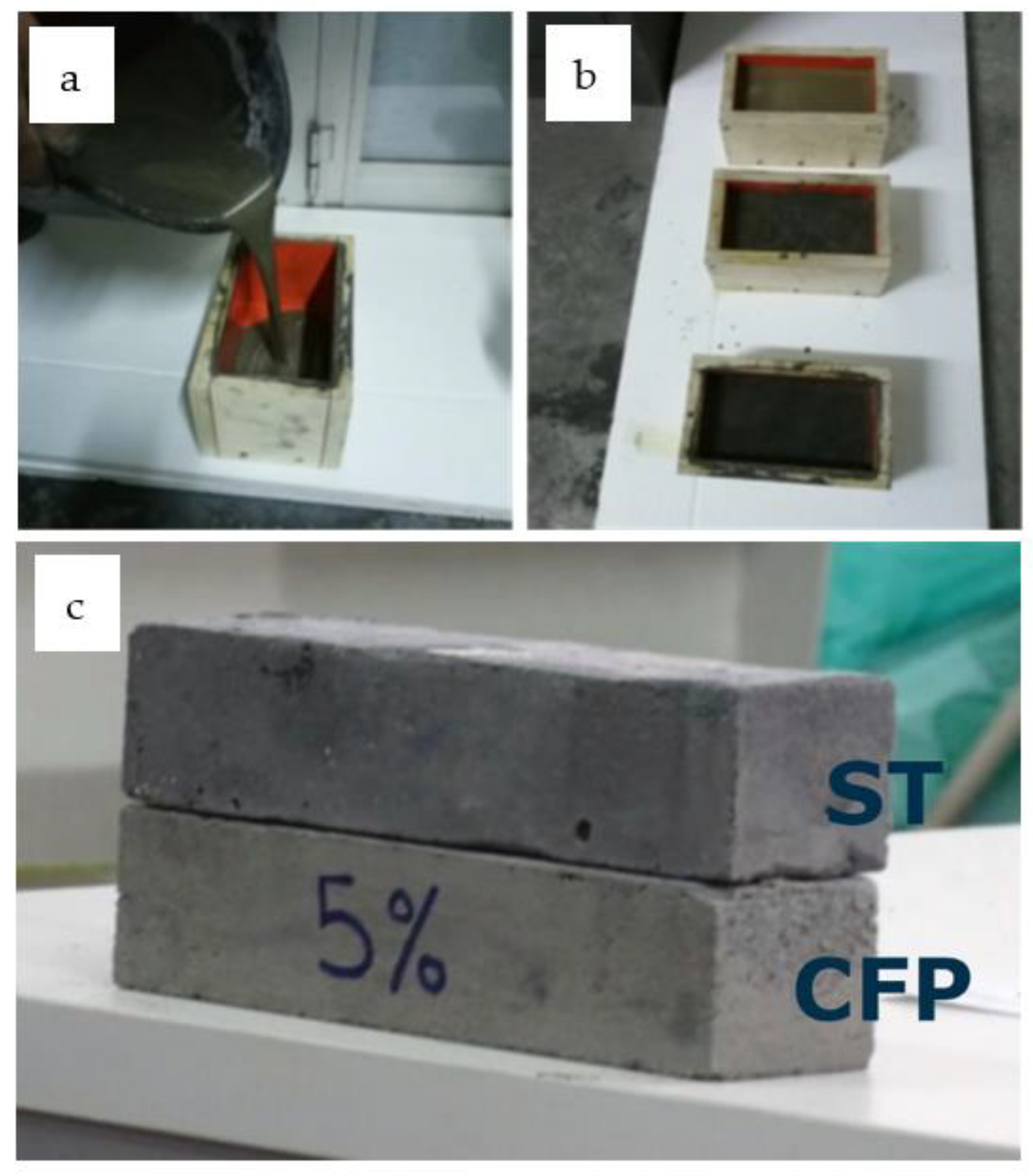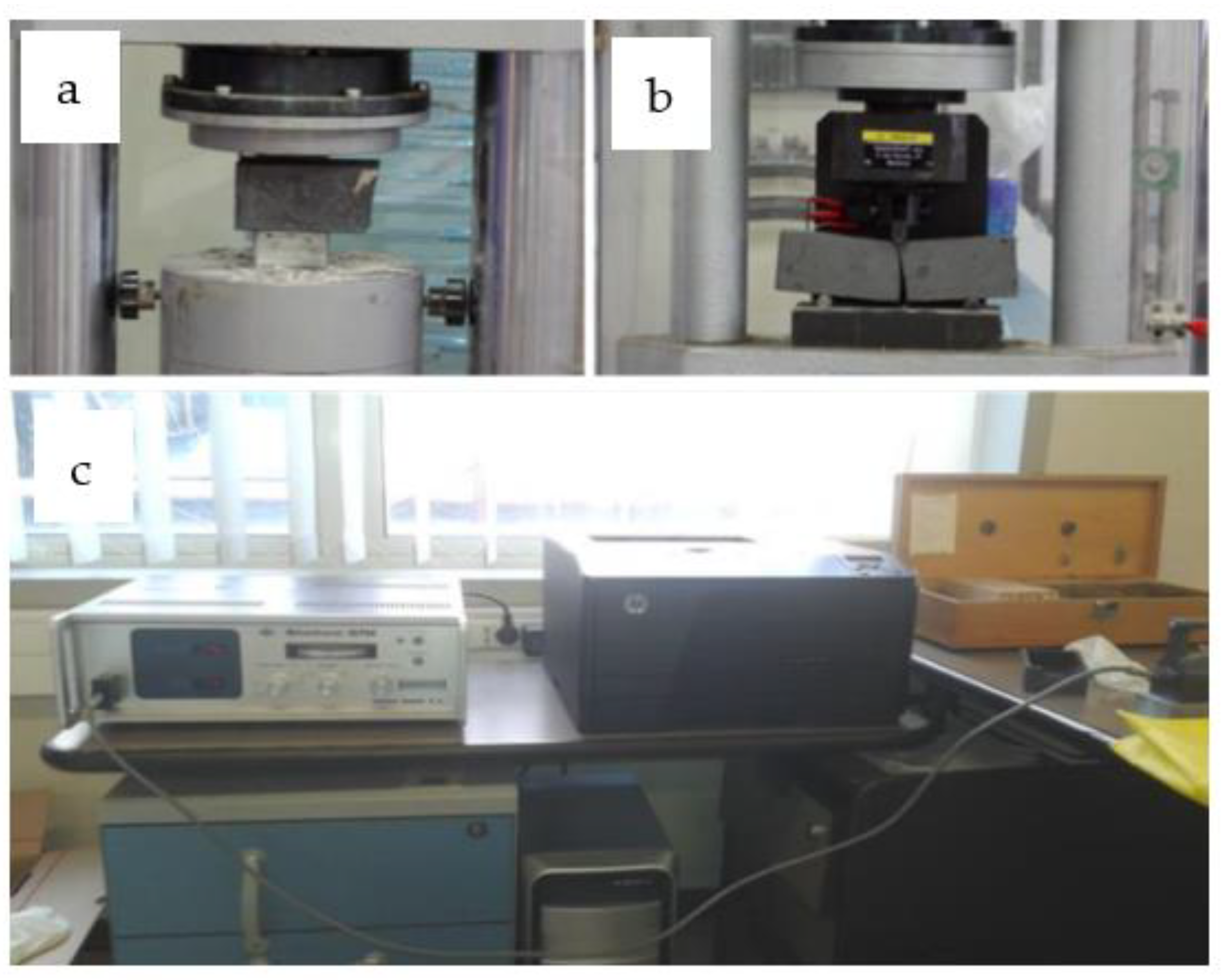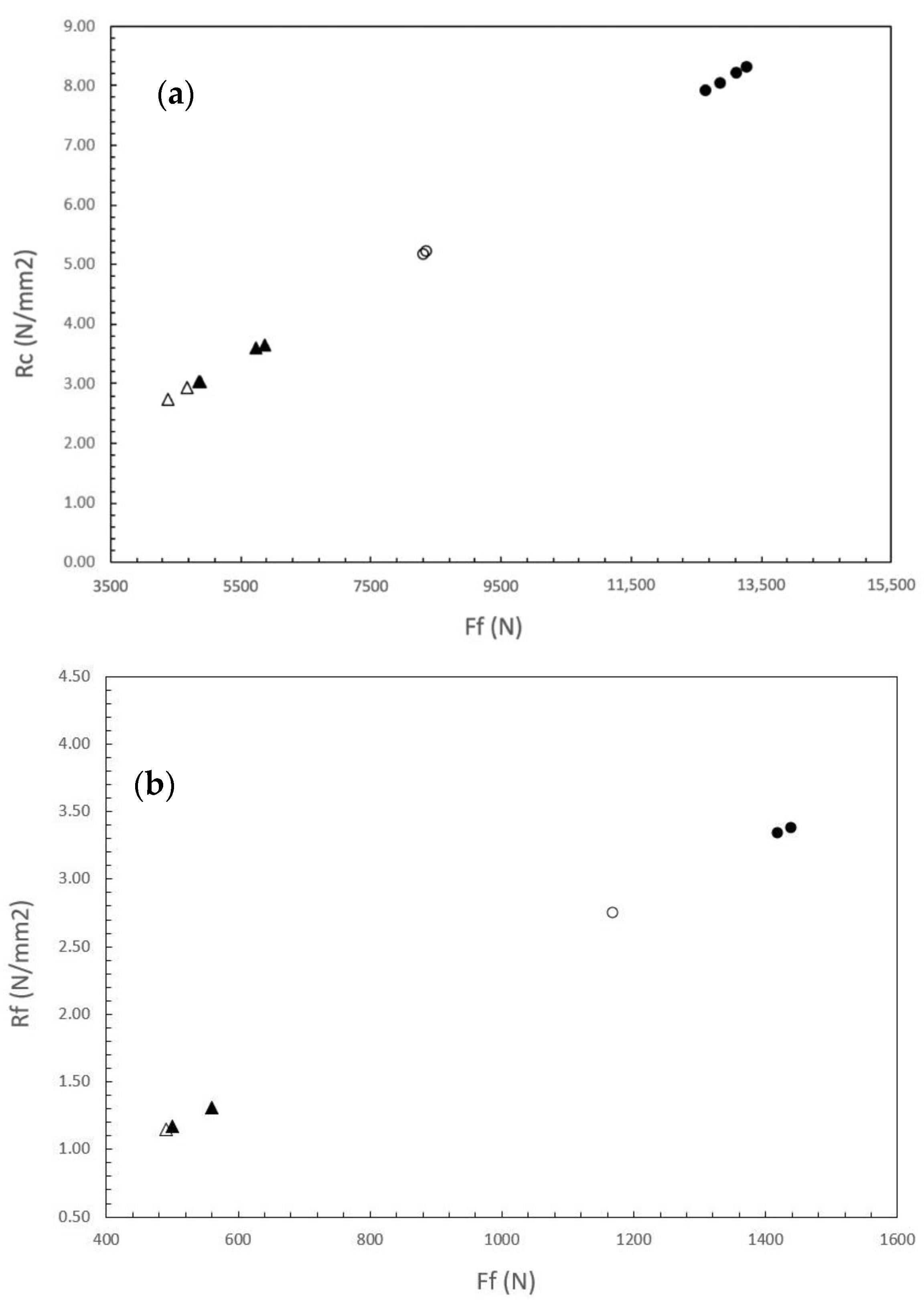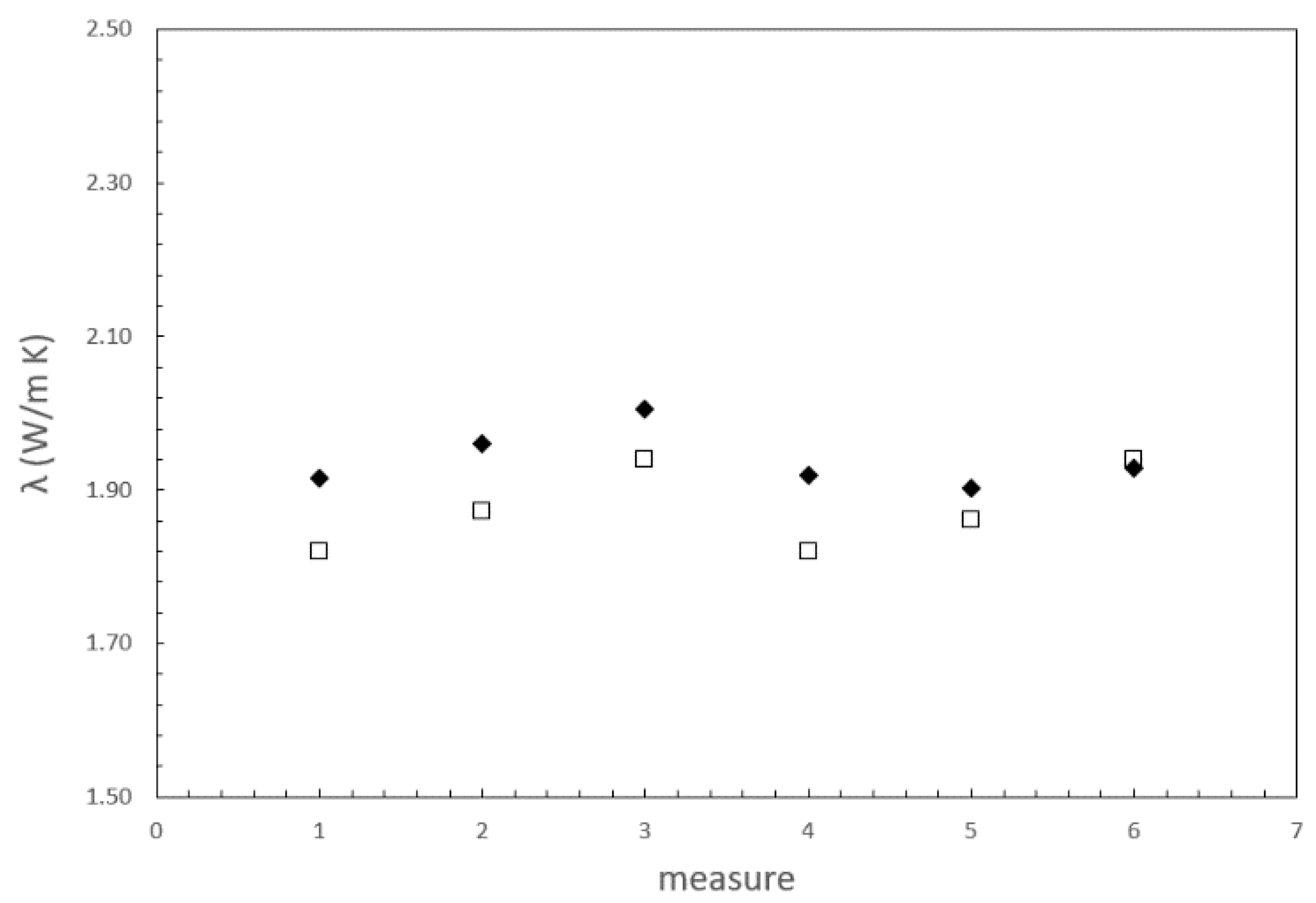Thermal and Mechanical Improvement of Filling Mixture for Shallow Geothermal Systems by Recycling of Carbon Fiber Waste
Abstract
:1. Introduction
2. Materials and Methods
3. Results
3.1. Compressive Strength Test
3.2. Flexural Strength Test
3.3. Thermal Conductivity Tests
4. Discussion
4.1. Implication on Boreholes Dimensioning
4.2. End of Waste and Economical Implication on Geothermal Applications
5. Conclusions
Author Contributions
Funding
Institutional Review Board Statement
Informed Consent Statement
Data Availability Statement
Acknowledgments
Conflicts of Interest
References
- Langsdorf, S. EU Energy Policy: From the ECSC to the Energy Roadmap 2050; Green European Foundation: Brussels, Belgium, 2011. [Google Scholar]
- Karlsson, C.; Silander, D.; Pircher, B. Smart, Sustainable and Inclusive Growth: Political Entrepreneurship for a Prosperous Europe; Edward Elgar Publishing: Cheltenham, UK, 2019; ISBN 9781788974080. [Google Scholar]
- Fetting, C. “The European Green Deal”, ESDN Report; ESDN Office: Vienna, Austria, 2020. [Google Scholar]
- European Commission. The European Green Deal. Communication from the Commission to the European, The European Council, The Council, The European and Social Committee of the Regions; European Commission: Brussels, Belgium, 2011. [Google Scholar]
- European Commission. An EU Strategy on Heating and Cooling. Communication from the Commission to the European, The European Council, The Council, The European and Social Committee of the Regions; European Commission: Brussels, Belgium, 2016. [Google Scholar]
- Lund, J.W.; Toth, A.N. Direct Utilization of Geothermal Energy 2020 Worldwide Review. Geothermics 2021, 90, 101915. [Google Scholar] [CrossRef]
- Banks, D. An Introduction to Thermogeology: Ground Source Heating and Cooling; John and Wiley and Sons: Hoboken, NJ, USA, 2012. [Google Scholar]
- Midttømme, K.; Banks, D. Ground-Source Heat Pumps and Underground Thermal Energy Storage: Energy for the Future. NGU Spec. 2008, 11, 93–98. [Google Scholar]
- Rybach, L. CO2 Emission Mitigation by Geothermal Development-Especially with Geothermal Heat Pumps. In Proceedings of the World Geothermal Congress, Bali, Indonesia, 25–29 April 2010. [Google Scholar]
- European Geothermal Energy Council. EGEC Geothermal Market Report, 2018, 8th ed.; EGEC: Brussels, Belgium, 2019; ISBN 9788578110796. [Google Scholar]
- European Geothermal Energy Council. EGEC Geothermal Market Report, 2019, 9th ed.; EGEC: Brussels, Belgium, 2020. [Google Scholar]
- Remund, C.P. Borehole thermal resistance: Laboratory and field studies. ASHRAE Trans. 1999, 105, 439. [Google Scholar]
- Mahmoud, M.; Ramadan, M.; Pullen, K.; Abdelkareem, M.A.; Wilberforce, T.; Olabi, A.G.; Naher, S. A Review of Grout Materials in Geothermal Energy Applications. Int. J. Thermofluids 2021, 10, 100070. [Google Scholar] [CrossRef]
- Viccaro, M. Doped Bentonitic Grouts for Implementing Performances of Low-Enthalpy Geothermal Systems. Geo-Therm. Energy 2018, 6, 4. [Google Scholar] [CrossRef] [Green Version]
- Indacoechea-Vega, I.; Pascual-Muñoz, P.; Castro-Fresno, D.; Calzada-Pérez, M.A. Experimental Characterization and Performance Evaluation of Geothermal Grouting Materials Subjected to Heating-Cooling Cycles. Constr. Build. Mater. 2015, 98, 583–592. [Google Scholar] [CrossRef] [Green Version]
- European Commission. Changing How We Produce and Consume: New Circular Economy Action Plan Shows the Way to a Climate-Neutral; Competitive Economy of Empowered Consumers: Brussels, Belgium, 2020. [Google Scholar]
- Naslain, R. Carbon Fibers From Pan and Pitch. In Advanced Inorganic Fibers: Process-Structure-Properties-Applications; Wallenberger, F.T., Naslain, R., Macchesney, J.B., Ackler, H.D., Wallenberger, F.T., Eds.; Springer: Boston, MA, USA, 2000; pp. 233–264. ISBN 978-1-4419-8722-8. [Google Scholar]
- Karaipekli, A.; Sari, A.; Kaygusuz, K. Thermal Conductivity Improvement of Stearic Acid Using Expanded Graphite and Carbon Fiber for Energy Storage Applications. Renew. Energy 2007, 32, 2201–2210. [Google Scholar] [CrossRef]
- Macias, J.D.; Bante-Guerra, J.; Cervantes-Alvarez, F.; Rodrìguez-Gattorno, G.; Arés-Muzio, O.; Romero-Paredes, H.; Arancibia-Bulnes, C.; Ramos-Sánchez, V.; Villafán-Vidales, H.I.; Ordonez-Miranda, J.; et al. Thermal Characterization of Carbon Fiber-Reinforced Carbon (C/C). Appl. Compos. Mater. 2019, 26, 321–337. [Google Scholar] [CrossRef]
- Zhang, X.; Fujiwara, S.; Fujii, M. Measurements of Thermal Conductivity and Electrical Conductivity of a Single Carbon Fiber. Int. J. Thermophys. 2000, 21, 965–980. [Google Scholar] [CrossRef]
- DIN 1164-11; Special Cement—Part 11: Composition, Specification and Conformity Evaluation for Cement with Short Setting Time. European Standards s.r.o.: Pilsen, Czech Republic, 2003.
- UNI 11152; Aqueous Suspensions for Injections of Hydraulic Binders—Characteristics and Test Methods. Ente Nazionale Italiano di Unificazione (UNI): Milan, Italy, 2005. (In Italian)
- DIN 18136:2003–2011; Soil—Investigation and Testing—Unconfined Compression Test. European Standards s.r.o.: Pilsen, Czech Republic, 2011.
- UNI EN 196-1:2016; Methods for Test of Cements—Part 1: Determination of Mechanical Strengths. Ente Nazionale Italiano di Unificazione (UNI): Milan, Italy, 2016.
- ASTM E 1530; Standard Test Method for Evaluating the Resistance to Thermal Transmission by the Guarded Heat Flow Meter Technique. ASTM International: West Conshohocken, PA, USA, 2019.
- Fukai, J.; Kanou, M.; Kodama, Y.; Miyatake, O. Thermal conductivity enhancement of energy storage media using carbon fibers. Energy Convers. Manag. 2000, 41, 1543–1556. [Google Scholar] [CrossRef]
- Lee, C.; Park, M.; Nguyen, T.B.; Sohn, B.; Choi, J.M.; Choi, H. Performance Evaluation of Closed-Loop Vertical Ground Heat Exchangers by Conducting in-Situ Thermal Response Tests. Renew. Energy 2012, 42, 77–83. [Google Scholar] [CrossRef]
- Floridia, G.; Blandini, F.; Iuculano, S.; Belfiore, G.M.; Viccaro, M. Innovative Solutions for Improving the Heat Exchange in Closed-Loop Shallow Geothermal Systems. Energies 2020, 14, 108. [Google Scholar] [CrossRef]
- Ingersoll, L.R.; Zobel, O.J.; Ingersoll, A.C. Heat Conduction with Engineering, Geological, and Other Applications; University of Wisconsin Press: Madison, WI, USA, 1954. [Google Scholar]
- Kavanaugh, S.P.; Rafferty, K.D. ASHRAE Ground-Source Heat Pumps: Design of Geothermal Systems for Commercial and Institutional Buildings; American Society of Heating, Refrigerating and Air-Conditioning Engineers: Atlanta, GA, USA, 1997. [Google Scholar]
- American Society of Heating, Refrigerating and Air-Conditioning Engineers. ASHRAE Handbook: Heating, Ventilating, and Air-Conditioning Applications; Tullie Circle, N.E., Ed.; ASHRAE: Atlanta, GA, USA, 2007; ISBN 9781933742144. [Google Scholar]




| Component/Weight | Pure Material Mixture ST | Doped Mixture CFP |
|---|---|---|
| Standard material | 1000 g | 950 g |
| CF material | 0 | 50 g |
| Water | 440 mL | 440 mL |
| Pure Standard Material | Ff (N) | Rc (N/mm2) |
|---|---|---|
| 14 days | 4370 | 2.73 |
| 14 days | 4680 | 2.93 |
| 28 days | 4850 | 3.03 |
| 28 days | 4870 | 3.04 |
| 28 days | 5860 | 3.66 |
| 28 days | 5740 | 3.59 |
| Standard Material + 5% CFP | Ff (N) | Rc (N/mm2) |
| 14 days | 8350 | 5.22 |
| 14 days | 8290 | 5.18 |
| 28 days | 12,640 | 7.90 |
| 28 days | 12,870 | 8.04 |
| 28 days | 13,130 | 8.21 |
| 28 days | 13,280 | 8.30 |
| Pure Standard Material | Ff (N) | Rf (N/mm2) |
|---|---|---|
| 14 days | 490 | 1.15 |
| 28 days | 500 | 1.17 |
| 28 days | 560 | 1.31 |
| Standard Material + 5% CF | Ff (N) | Rf (N/mm2) |
| 14 days | 1170 | 2.74 |
| 28 days | 1420 | 3.33 |
| 28 days | 1440 | 3.37 |
| N of Measurements | Pure Standard Material ST | Standard Material + 5% CF |
|---|---|---|
| λ (W/m K) | λ (W/m K) | |
| 1 | 1.82 | 1.92 |
| 2 | 1.87 | 1.96 |
| 3 | 1.94 | 2.01 |
| 4 | 1.82 | 1.92 |
| 5 | 1.86 | 1.90 |
| 6 | 1.94 | 1.93 |
| λgrout [W/m K] | λprobe [W/m K] | Rgrout [m K/W] | Rprobe [m K/W] | Rb_tot [m K/W] | |
|---|---|---|---|---|---|
| ST | 1.82 | 0.45 | 0.08 | 0.05 | 0.13 |
| CFP 5%gr | 2.01 | 0.45 | 0.07 | 0.05 | 0.12 |
| CFP_innovative | 2.01 | 1.30 | 0.07 | 0.01 | 0.08 |
| ST | CFP 5%gr | CFP_Innovative | |
|---|---|---|---|
| Qa (W) | 4340 | 4340 | 4340 |
| Qh (W) | 158,000 | 158,000 | 158,000 |
| Rb (mK/W) | 0.13 | 0.08 | 0.07 |
| PLFm | 0.60 | 0.60 | 0.60 |
| Fsc | 1.04 | 1.04 | 1.04 |
| Tg (°C) | 14 | 14 | 14 |
| Tm (°C) | 4 | 4 | 4 |
| N° Vertical Probes | Linear Meters | |
|---|---|---|
| ST system | 42 | 4200 |
| STprobe + CFP 5%gr | 40 | 4000 |
| CFP innovative system | 36 | 3600 |
| ST System (Euro) | CF Innovative System (Euro) | |
|---|---|---|
| CFP disposal cost | 400 | 0 |
| CFP cost | 0 | 18 |
| Commercial Grout cost | 1302 | 1060 |
| Cost of commercial Probe | 40,173 | 0 |
| Cost of innovative Probe (PE−100) | 0 | 46,486 |
| Cost of geothermal perforation | 210,000 | 180,000 |
| Total amount | 251,875 | 227,564 |
Publisher’s Note: MDPI stays neutral with regard to jurisdictional claims in published maps and institutional affiliations. |
© 2022 by the authors. Licensee MDPI, Basel, Switzerland. This article is an open access article distributed under the terms and conditions of the Creative Commons Attribution (CC BY) license (https://creativecommons.org/licenses/by/4.0/).
Share and Cite
Floridia, G.; Urso, S.; Belfiore, G.M.; Viccaro, M. Thermal and Mechanical Improvement of Filling Mixture for Shallow Geothermal Systems by Recycling of Carbon Fiber Waste. Energies 2022, 15, 5806. https://doi.org/10.3390/en15165806
Floridia G, Urso S, Belfiore GM, Viccaro M. Thermal and Mechanical Improvement of Filling Mixture for Shallow Geothermal Systems by Recycling of Carbon Fiber Waste. Energies. 2022; 15(16):5806. https://doi.org/10.3390/en15165806
Chicago/Turabian StyleFloridia, Giovanni, Salvatore Urso, Giuseppe Maria Belfiore, and Marco Viccaro. 2022. "Thermal and Mechanical Improvement of Filling Mixture for Shallow Geothermal Systems by Recycling of Carbon Fiber Waste" Energies 15, no. 16: 5806. https://doi.org/10.3390/en15165806
APA StyleFloridia, G., Urso, S., Belfiore, G. M., & Viccaro, M. (2022). Thermal and Mechanical Improvement of Filling Mixture for Shallow Geothermal Systems by Recycling of Carbon Fiber Waste. Energies, 15(16), 5806. https://doi.org/10.3390/en15165806







